#theropod lips
Explore tagged Tumblr posts
Text

The sketches in sketchbook with toned paper. :) It's baryonychine (speculative reconstruction with "lips") and Spinosaurus, both done without references. In the process, I used a white pencil (I have hardly used it so far) for the light parts, it turned out to be a very good volume.
Black ballpoint pen, white pencil and gouache (for minor corrections), 2024.
#baryonyx#suchomimus#baryonychinae#spinosaurus#spinosaurinae#spinosauridae#theropod dinosaur#theropod lips#paleoart#sketches#toned paper
29 notes
·
View notes
Text
Oh how i wish i could have a euro every time i see pretentious paleoart featuring bad anatomy with ugly speculative soft tissue on top.
Oh how i wish i could have a euro every time i see pretentious paleoart that has terrible fucking visual composition.
#paleontology#paleoart#this is mainly about influencer copycats btw#i can't even count how many times i've seen the ugly big jowl lips spec tissue on otherwise extremely shrinkwrapped theropods
37 notes
·
View notes
Text


Dino figure of the day: Eofauna Tyrannosaurus rex "Sue"
#dino figure of the day#eofauna#tyrannosaurus#dinosaur figure#theropod#tyrannosaur#love her chonky bear lips#...weird phrase out of context
22 notes
·
View notes
Text
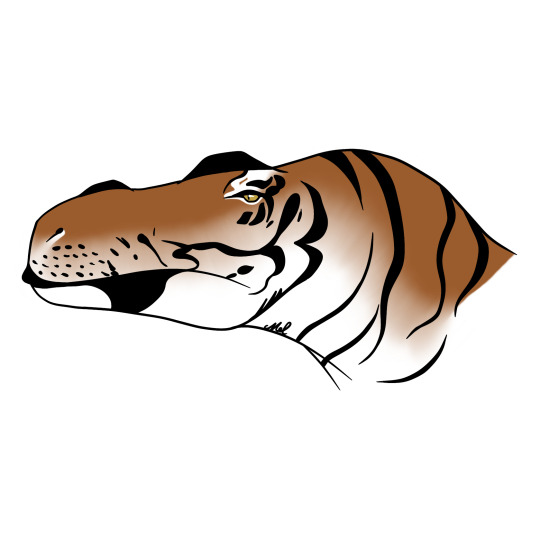
Dinovember 2023 Day 1:
Saltriovenator // Tiger
Obviously, I'm not an accurate Paleoartist, but I tried my best. Side view because I have every little experience drawing dinosaurs.
-XOXOX-
Please don't repost or use any AI on my art. Thank you.
#dinovember#dinovember2023#art#original art#my art#dinosaurs#saltriovenator#yes i gave the dino lips#theropod#ceratosaurian
76 notes
·
View notes
Text
New paper supporting lipped theropods was just released!
They looked at the wear patterns on the enamel of a crocodile tooth and a daspletosaurus, as well as the skull length/tooth height relationship for multiple theropods and monitor lizards.
The crocodile tooth had more wear on its exposed side, while the daspletosaurus tooth had similar enamel thickness on both sides, indicating that they were likely covered by soft tissue, which keeps enamel moist and resistant to wear. They also found that theropods did not have a larger relative tooth size than monitor lizards do - the largest teeth belonged to the crocodile monitor, which has extensive soft tissue covering its teeth. This means that even Tyrannosaurus could plausibly have had their teeth completely covered by lips despite their size.
53 notes
·
View notes
Text
wildclaws may not have correct theropod wrists but at least they have lips over their teeth, ahead of their time with that one
#g postin#goanna posting reminded me of dis#ppl seem to just recently be getting ok with theropod lips
7 notes
·
View notes
Text
More Dino Art
Tyrannosaurus Rex (closed mouth)

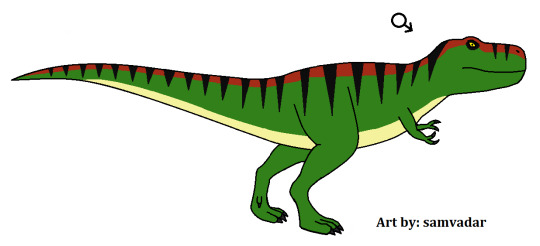
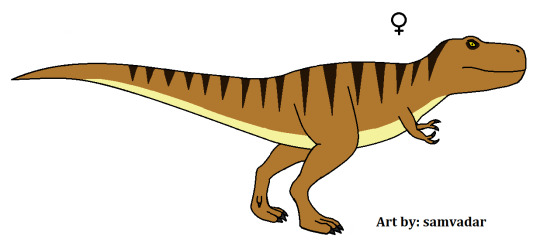
#ooc post#dinosaurs#done with microsoft paint#tyrannosaurus rex#tyrannosaurus#lips#i believe that they (as well as all other theropods) had lips
1 note
·
View note
Text
More things that I left out because tumblr has an image limit
While the mechanoreceptors/trigeminal nerves in alligators as well as crocodilians are very similar to T. Rex there is still the lacking of lips to protect the enamel of their teeth.

Mechanoreceptors in alligator face

The rostral neurovascular canals of Tyrannosaurus rex (FMNH PR 2081) in lateral view (top) and two cross-sections (CT slices, bottom). Scale bar equals 30cm.
This is where waterfowl come in as not only do they share similar trigeminal nerves and mechanoreceptors that both alligators and theropods have.


The morphology and distribution of cutaneous mechanoreceptors in bill and tongue of the mallard(upper and lower bill)
They also have skin that acts like a lip, hanging from the edge of the mandible and hanging over the lamellae as if they were teeth.


Preserved pecking duck head showing where the bone ends and the skin hanging below begins.(first) male wood duck with mouth open showin how the upper bills lamellae are hidden(second)
In comparison to reptiles that lack these intricate mechanoreceptors that not only run through the skin of the animals, but also inside the bones of the nasal and mandibular cavities.
Only having a papillae attached to the receptor on or near the edge of individual scales and the nerves they attach to only being skin deep in comparison to archosaurians like alligators, theropods, and waterfowl.


The skin sense organ of some iguanian lizards
If the lack of formina for corpuscles/trigeminal nerves/mechanoreceptors on the mandibles of reptilians outside of the ones that run along the lips isn’t enough, hopefully seeing the neural pathways in both alligators and waterfowl and comparing them helps.
Theropod Facial structure theory
I have been trying to write this paper out so many times and the lack of funds to hire an editor/publish as well as getting this organized in a fashion that's considered proper for a scientific paper has caused me to hit so many walls, not including the learning disabilities that have made this worse to get this out. So i'm doing this to get what information i've been gathering since 2018.
looking at young corvid images of their open mouth, they had a lip area in their mouth that the upper beak would overlap and lay in perfectly, this is what started me down the road along with noticing the formina on the sides of theropod faces matched that of goose skulls I saw online. As I had no access to actual specimens in person.
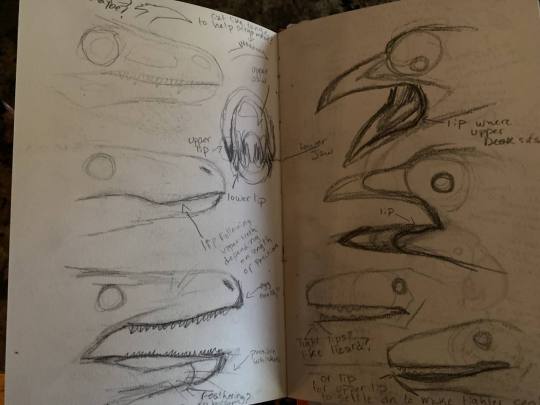
feeling as though waterfowl specimens were the easiest to obtain(they were actually more difficult than thought) as well as being closer to dinosaurs on the evolutionary tree next to ratites, and even living along dinosaurs during the late cretaceous ie presbyornis, they seemed to be the best to study for this.
After obtaining a pair of peking duck and an african goose, from some local farmers that donated them, they were dissected and preserved using techniques learned from taxidermy for study. The specimens had one side of their bills removed while leaving the skin intact on the otherside. One of the peking ducks kept the tissue on both sides, while only one side had the top layer of the epidermis removed, exposing the harder dermis underneath. A noticeable attribute was that before preservation the bills were plump and didn't show any texturing, except for the goose around the back nearest to the corner of the mouth. Once preserved however, the skin on the bills shrank, revealing grooves and texturing where nerves and blood vessels would run.
The sensory organs and nerves that ran in the bills were observed using a candlelight method/ie holding them up to the light.
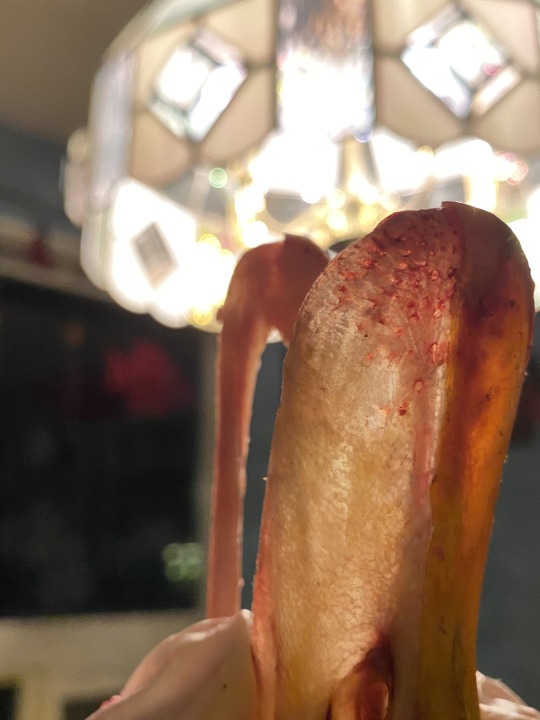
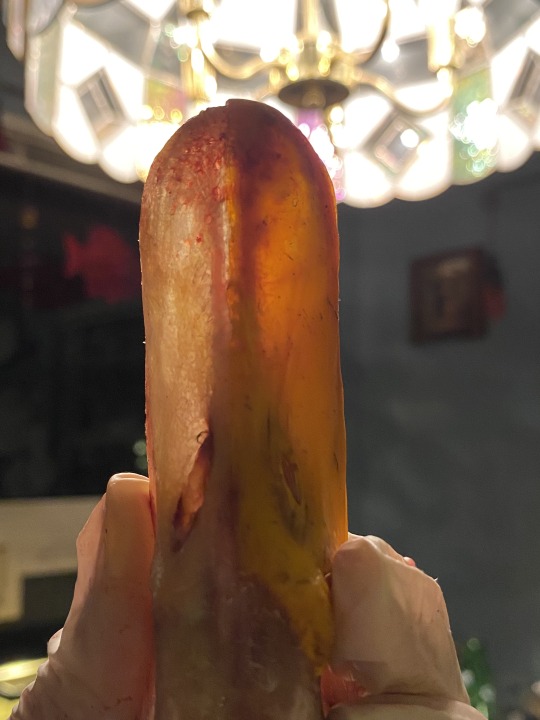

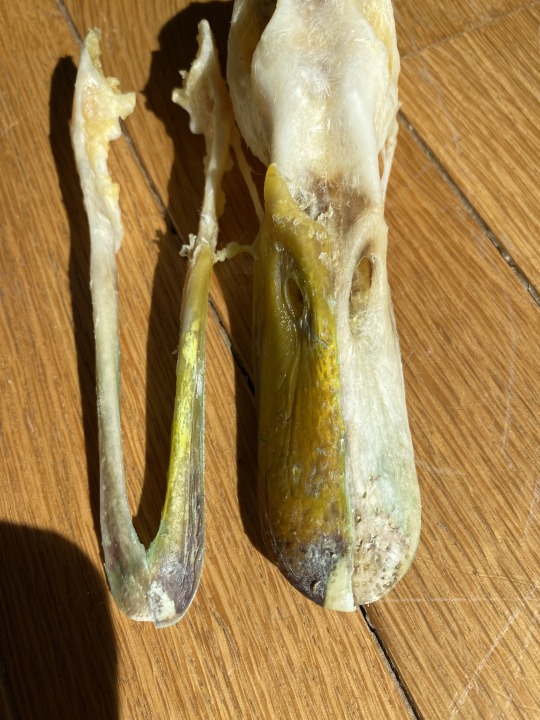

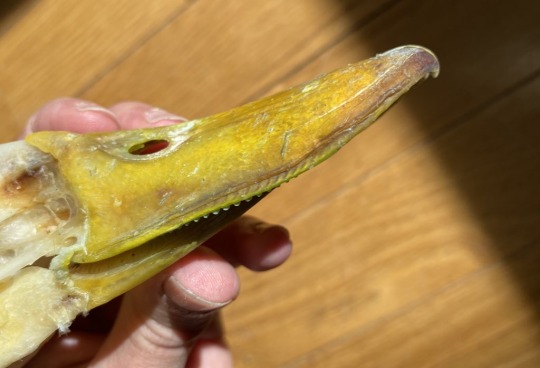
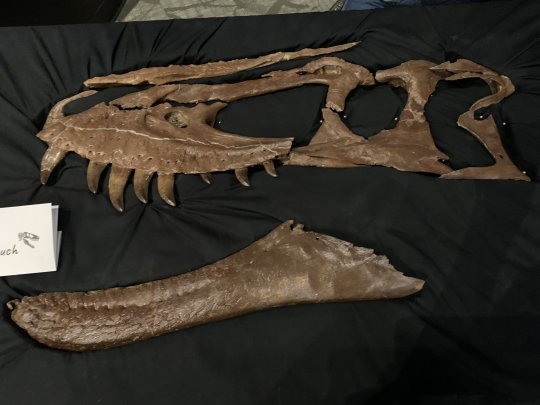
Tyrannosaurus Juvenile Jane specimen for comparison
The deep grooves and formina on the bill, as well as the formina and grooves that are seen in T.Rex have many similarities, which was the main focus of this study as they're are numerous studies pertaining to their sensory organs. Also something to compare is that there is a distinct row of formina that's more prominent on older crocodiles and alligators along the dentiary similar to that of T.Rex, on both the top and bottom row of the mandibles.

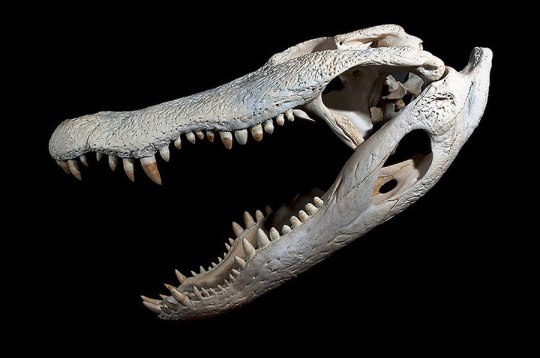
saltwater crocodile head from crocodiledarwin.com and alligator from encyclopediaofarkansas.net

komodo dragon profile view(comparing formina)
Though waterfowl having lamillae cannot be used to compare enamel ware. While crocodiles and alligators have teeth, but are known for not having lips, have ware and tare on their teeth than animals like monitor lizards that have lips as shown in this study using a relative of Tyrannosaurus rex to prove they had some form of lip to protect their tooth enamel.
Another observation is that in alligators the bottom row of dentary is tucked under the upper mandible and covered more than in crocodilians. It would be interesting to see the tooth study done with other teeth on both animals, as some of the posterior dentary on the upper mandible can sometimes be seen tucking away in a pocket of skin as protection in some alligators.
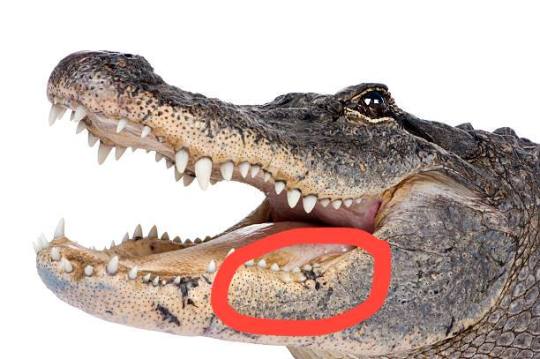
Also looking at neonatal alligators shows a depression in the lower jaw area that the upper dentary could sit in, almost as though their reminants of lips

neonatal alligator from natgeo on alligator facial mechanoreceptors
and while alligators and crocodilians seem to have scaling on their face this is just thickened sensitive skin with cracked texturing imitating scales. Bills on waterfowl are also thickened as this allows them to forage in merky waters and plants without damaging their bills. While both animals have thickened skin on their manidbles, it is still a very sensitive part of their body that they use to navigate and explore/manipulate their environment as well as interact with other of their species. While reptiles have less sensitivity and do not share these organs along their faces(the skin sense organ of some iguanian lizards). This could be also a lack of information on the anatomy of reptile skulls and facial structures that could be expanded more for comparison.
However there was a study done on the facial sensitivity of Tyrannosaurus along with alligators
See Complex Neurovascular system in the dentary of Tyrannosaurus
See Despite their thick skins, alligators and crocodiles are surprisingly touchy
and while it took awhile to find and make available, there had been a paper written on a very similar organ within the bills of waterfowl, namely mallard ducks.
See The Morphology and Distribution of Cutaneous Mechanoreceptors(Herbst and Grandry Corpuscles in Bill and Tongue of the Mallard)
And while Monitor lizards and other reptiles share a similar formina pattern, they lack the textured grooves and sensitive organs archosaurs and certain avians share, as well as other anatomical features of moniotor lizard skulls that they share more closely with other reptiles and snakes than they do with the archosaurians and avians.

komodo dragon skull ventral view
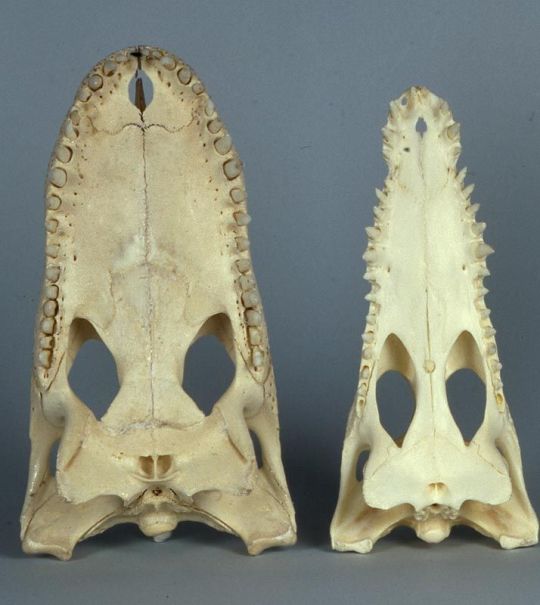
Alligator(left) Crocodile(right) ventral views of skulls

Peking Duck skull with bill skin(ventral view)

T.Rex skull ventral view
another observation in many reptile skulls is how the upper and lower dentary interact. While some had teeth that overlapped the lower mandible, there seemed to be somewhere that the teeth met, either at the anterior end of the skull or continually all around, in monitors there was some sort of gap at the anterior portion of the dentary to make way for the tongue to be able to slide in and out without being obstructed too much while allowing the mouth to stay closed. Where as archosaurs and avians the two overlapped one another allowing for a scissoring affect with the teeth, the most noticeable being the anterior end of the mandibles. And while waterfowl lack the dentary that archosaurs and reptiles have, the lamillae still slide past one another similar to what's observed in many theropods, even in non avian dinosaurs. The thought of bone to tooth contact is considered as well, and there can be a sizeable closure without the need for the amount of soft tissue observed in reptiles.
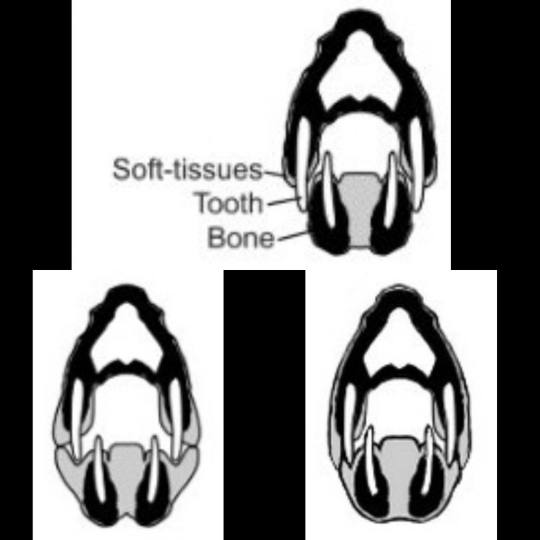
proposed crocodilian like contact of tooth on mandible(top), proposed soft tissue similar to that of monitor lizards(bottom left), new proposed soft tissue without scaled lips(bottom right)
Having soft tissued lips that is similar to that of a waterfowls bill allows for the mechanosensory corpusicules to interact as well as still allows for protection of the tooth enamel.
The way their upper dentary line up with their lower mandibular formina seems to follow the same pattern, compared to reptiles that didn't curve upwards towards the anterior portion of the lower mandible. There's also a possibility of having a nail, like waterfowl, or some large scale, like many other reptiles with dentary, at the anterior ends of the upper and lower manible. This is due to the amount of formina clustering in a pattern like structure similarly seen in both waterfowl and reptiles.
These observations and studies allowed for an idea of how to reconstruct Tyrannosaurus Rex




Juvenile Jane Tyannosaurus Rex skull, with open and closed mouth(top) and reconstructions
Even constructing a physical reconstruction to better observe how the lips and teeth would interact.
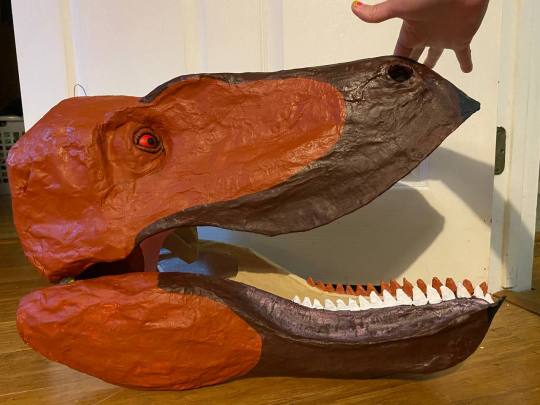
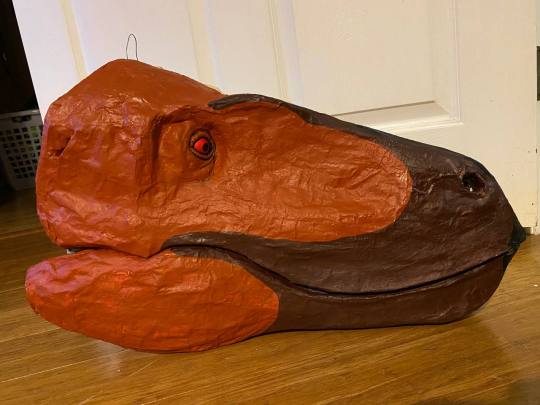
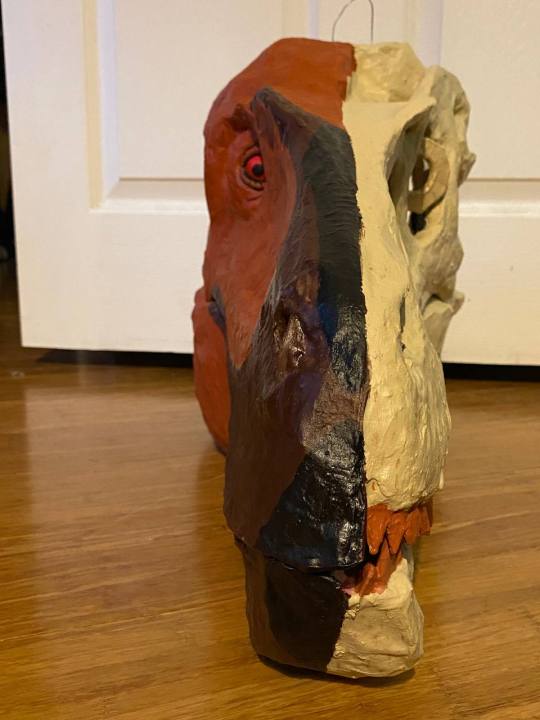

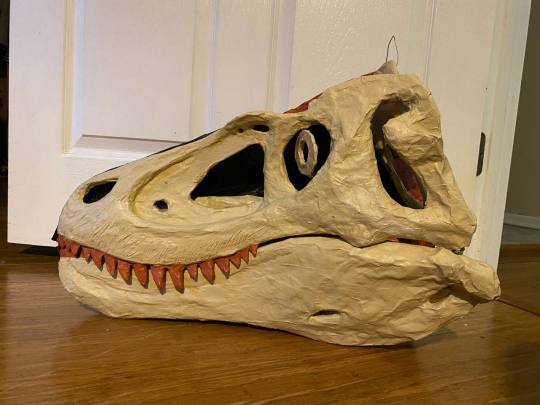
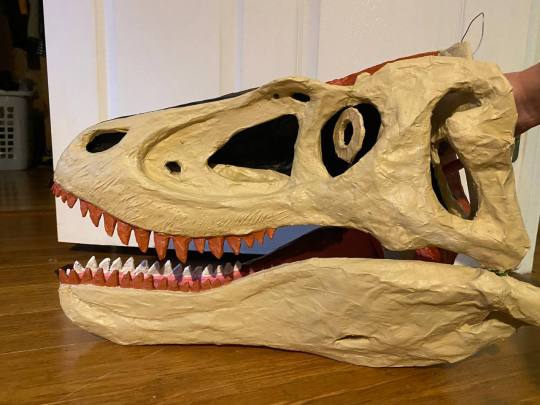
Paper mache head reconsturction done in a similar manner to the duck and goose specimens used in this study
Also when reconstructing, and also accounting for tooth slippage, there was an issue with a sizable gap at the anterior end with the front dentary when closing the jaws when attempting to imitate the mouth closing similar to that of previous reconstructions using reptile lips, where as with the more waterfowl skin reconstruction there was less of an issue and also less of an overhanging bottom lip.
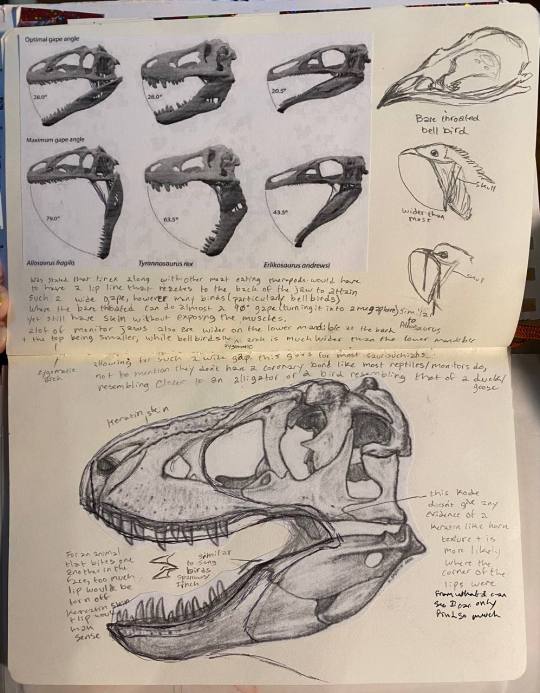
Pages from personal study notes
There was also the issue of either exposing the jaw muscles similar to how crocodilians, alligators, and other reptiles are observed to have, or to cover it in skin like birds. One of the arguments is that the mouth wouldn't be able to open to the extent allosaurians and tyrannosaurus are able to open their mouths. When there are several avian species with skin over the area that can very well open their mouths just as wide, ie Bell Birds, which have a widened jugal bone like that of tyrannosaurus.

Young tyrannosaurus specimen(chomper)
Also to note, in most reconstructions where there is a bony knob on the jugal, circled in the above example, is more than likely a muscle attachment point, and the divet in the space before the attachment point could allow for the corner of the lips to sit.
In conclusion, Tyrannosaurus Rex and possible other theropod dinosaurs with similar skull anatomy of the upper and lower mandibles more than likely had thickened yet sensitive skin with a lip like structure similar to that of waterfowl and not a scaled skin.
Additional research papers on duck bill anatomy/mechanreceptors
Histomorphogenesis of Upper Beak in Muscovy Ducks (Cairina moschata)
3D architecture and a bicellular mechanism of touch detection in mechanosensory corpuscle
Molecular basis of tactile specialization in the duck bill
Personal Notes on research
#paleoart#paleontology#science#science writing#study#animal study#animal biology#mechanoreceptors#corpuscles#duck#theropod#dinosaur#trex#tyrannosaurus#Tyrannosaurus rex#monitor lizards#lips on dinosaurs#dinosaur anatomy#anatomy#animal anatomy#paleo reconstructions
294 notes
·
View notes
Text

Highly speculative Spinosaurus paleoart! There's a lot going on here, I tried to take into account its ecological niche of being a river walking fish eater. Sort of stork or heron-like. I don't see much of a need to blend in being such a massive and niche animal. So I based the coloration on some semi aquatic birds. I increased the size of the head crest by a lot because I ADORE the idea of large theropods with bird-like crests and combs. Honestly I think it could have been even more extravagant for sexual selection, but who knows. I also covered parts of the "beak" with a hard covering that extends up the face and onto the crest. And added lips because I feel like that just makes sense with how the skull looks. But I'm not a paleontologist so!! Who knows!! Big duck!
675 notes
·
View notes
Note
What do you think about the walking with dinosaur trex? As a kid I always thought the head looked really boxy, it looks very distinct from other trexes I’ve seen around.
Walking With Dinosaurs Tyrannosaurus is,,,, Bad
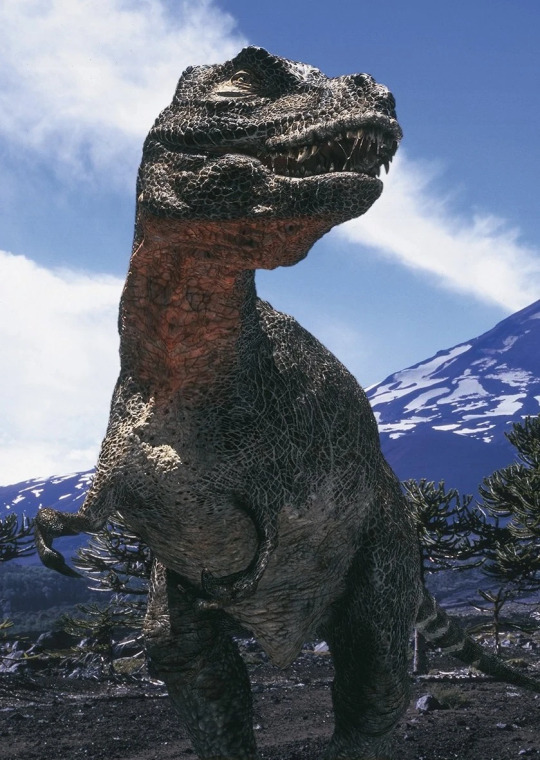
I'm not sure what it is about WWD and large theropods but both the Tyrannosaurus and Allosaurus look really Weird, especially in the head. Allosaurus's horns got placed directly over its eyes, and the whole shape of the head is really triangular.
With the Tyrannosaurus, the head is just. a Block.
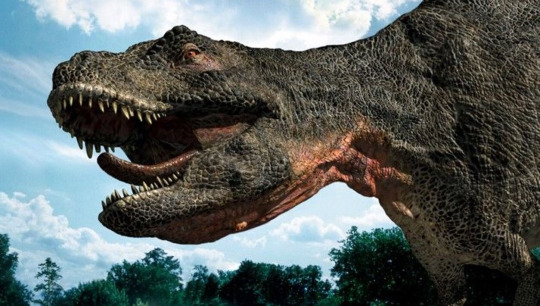
Proportionally it's shorter and thicker than a real Tyrannosaurus skull, and while the shape of the lower jaw is actually pretty close the back of the skull is where issues really start to crop up.
They've ticked all the boxes in the abstract: big brow ridges, wide back of the skull, heavy lower jaw. But the execution of them really falls flat. Mark Witton's reconstruction from the recent theropod lips paper actually makes a very good comparison here since it's almost at the same angle:

The body itself is oddly proportioned too, with very long legs, and shorter thinner tail, long arms, and a thin neck. Overlaying Scott Hartman's Tyrannosaurus skeletal over the top of it really brings out the Weirdness

In some areas, like with all of WWD, the inaccuracies here are due to Science Marching On (the lack of lips and the shallower torso due to differently-reconstructed gastralia). But most of the problems with how the head is shaped were just at inaccurate in 1999 as they are now, and it's a little baffling to me how such a famous and well-studied dinosaur ended up looking so... Off?
On the other hand, the actual behaviour of the Tyrannosaurus is fantastically naturalistic, and the colour pattern is very appealing and absolutely iconic. It's just kind of a shame that it got combined with this odd, lumpy anatomy
351 notes
·
View notes
Text

Day 3: Camouflage
A basal crocodylomorph Hesperosuchus agilis is hidden in a paleo-ferns to avoid predators such as other basal theropods.
Speaking of which, resent studies that hesperosuchus suggested a possibility extistence of lepidosaur-like lips that protected its teeth from the outside, like theropods have.
#my art#paleoart#my drawings#croctober#croctober24#crocodylomorpha#hesperosuchus#late triassic#archosaurs#artists on tumblr
9 notes
·
View notes
Text

The portrait of the abelisaurid theropod Abelisaurus comahuensis that I made last year. I tried to work in a style like acrylic paints, but with monochrome. I like some aspects of this work, such as the eye and the keratin around it, but it's clear from the skin folds and facial scales that I have a lot to learn. I hope to do a remake of this in the future, but in a slightly different style. Done in Paint Tool Sai 2.0.
#abelisaurus#carnotaurus#majungasaurus#abelisauridae#theropod#theropod lips#late cretaceous#paleoart
23 notes
·
View notes
Note
Name 10 really Good animals but the kicker is No Mammals.
Bonus points if you list why they're good
oh god oh fuckuhhhh
1. bearded vulture, bc eating almost nothing but bone and bone shards is raw as fuck
2. golden eagle, bc just like snow leopards they figured out they can kill goats with gravity instead of sharp force trauma
3. gharials, bc though all extant crocodilians are very good moms gharials are the only ones i know of who are also good dads. also they look so sillay
4. thresher shark. boy why are you so tail (it’s to concuss fish. king of CTE)
5. antlion. people only shit on camping because it WORKS
6. goliath tiger fish, because like what the fuck man. cmon.
7. crocodile monitor, because t e e t h. everyone who believes non-avian theropods would have had their teeth sticking out of their lips needs to take a peep at this lizard.
8. glass coral, bc a single individual can live for like twenty THOUSAND years. without wifi
9. gaboon viper, bc theyre so cute and so chunky but watch out!
10. moon jelly, bc being a plastic bag has done them plenty of good for the past hundreds of millions of years. if it works it works. i guess.
6 notes
·
View notes
Text

I thought I was done with the dinosaur stuff for now but I keep reading more and thinking more and doubting my conclusions again.
So I drew this Heterodontosaurus to show all the possible mouths I believe dinosaurs could have. The "carnivorous lizard" model would clearly be ancestral and retained in typical theropods (and maybe Heterodontosaurus itself is basal enough to still have it), "herbivorous lizard" makes sense for sauropods, and "bird" is for theropods with fully beaked toothless jaws - like birds. Ornithischians, though, are a bit complicated. They have beaks, but not like birds, and their inset tooth rows are kinda like a more extreme version of what we see in lizards like Uromastyx... Not to mention that more derived ones, like ceratopsids, have these weird giant jaw muscles. I tried a similar approach with my drawing of Chasmosaurus:

The "herbivorous lizard" looks weird (which may be just because it's a quick edit of a picture that wasn't intended for it), but the condor-like "bird" suddenly breathes new life into the cheek concept I've been trying to refute... but that's all assuming that Nabavizadeh's muscle reconstruction is correct in the first place. Maybe I should read his Illustrated Guide to Dinosaur Feeding Biology if my depression lets me.
Also, almost forgot - the beak thing. I've depicted versions of Heterodontosaurus beak both uncovered and covered by a Trionyx-like lip. While the beak doesn't really need covering, the teeth above it probably do.
9 notes
·
View notes
Text
Did phytosaurs have lips?
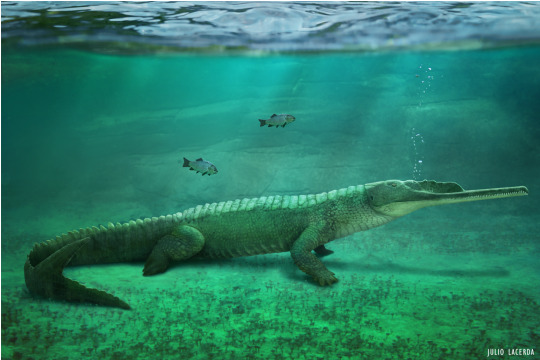
Mystriosuchus planirostris by @paleoart, the inspiration for this post.
2016 was many things, but one of the best was definitely being the call out year for many archaic paleoartist mistakes. One of these was the absence of lips in many reconstructions, from the skin-wrapped maws of theropod dinosaurs to the bare-toothed saber-toothed cats to the rather ridiculous depictions of entelodonts and other prehistoric mammals as fanged demons. This year saw the publication of various papers showing that teeth do generally in fact need lips to be protected from damage and moistened, meaning that many animals traditionally reconstructed as bared-toothed monsters need a healthy amount of oral tissue.
That said, things aren’t black and white. Crocodilians, after all, still have bare teeth. In one of these papers, Larson et al 2016, it’s been suggested that their aquatic habits compensate for their lack of lips, as humidity certainly isn’t a problem. However, as the Mark Witton link above informs you, many crocodiles go through prolonged periods of life on land without tooth degradation. It also doesn’t cover how terrestrial crocodylomorphs would have coped with the absence of lips, or why many aquatic vertebrates like dolphins (Platanista aside) still kept their lips.
It seems, therefore, that crocodiles are simply off in this regard. Their liplessness actually appears to derived from a highly unusual facial development process, which essentially renders their entire face a single “scale”. This seems to have evolved in order to develop the extensive Integrumentary Sense Organs (ISOs), thinning the facial skin in order to increase sensivity, and it carried over into their terrestrial descendants.
This obviously raises the question of whereas groups similar ecologically and morphologically to aquatic crocodilians underwent a similar process. Where they also lipless, or did they in fact retain their lips, making comparisons to crocodiles all the more questionable?
The Phytosaurs
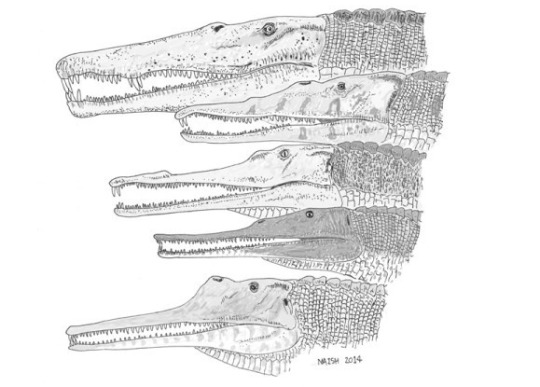
Phytosaur head diversity by Darren Naish. Taxa included: Smilosuchus gregorii, Pravusuchus hortus, Mystriosuchus westphali, Paleorhinus bransoni and Pseudopalatus pristinus.
Phytosaurs were, in some respects, the “original crocodiles”, having evolved and prospered long before crocodylomorphs ever touched the water. Although they weren’t particularly closely related (birds are closer to crocodiles than phytosaurs are), these archosauriform reptiles did hit most of the same notes as crocodiles: barrel-shaped bodies, extensive osteoderm armours (in some cases even better protected, due to the bell-shaped cap on the throat and various scutes on the forelimbs and belly), generally short limbs and large, paddle-like tails.
While some phytosaurs explored odd ecological niches – Nicrosaurus and similar taxa are adapted to a primarily terrestrial lifestyle, while Mystriosuchus was inversely so specialised to life in the water that it was practically the Triassic Metriorhynchus -, a generally semi-aquatic lifestyle for most phytosaurs can be inferred due to due sheer prevalence in freshwater and shallow marine deposits, limb proportions and shape, laterally flattened and powerful tails and retracted nostrils (though keep reading).
Various tracts attributed to these animals similarly imply a close functional match between phytosaurs and crocodiles. Various swimming tracts have been attributed to phytosaurs, while the Apatopus footprints show an interesting insight on these animals’ terrestrial locomotion capacities, being capable of an erect gait like archosaurs and mammals, including modern crocodiles and alligators. Paleopathology studies indicate similar behaviours such as interspecific biting (hence the need for strong armour), and perhaps more damningly endocast studies show that the general phytosaur brain shape was rather similar to that of modern crocodilians (albeit with a few differences, like the size of the brain and the presence of multiple sinuses; see below).
For all intents and purposes, phytosaurs were functionally crocodilian, offering one of the most extreme cases of convergent evolution ever recorded. But no matter how close, phytosaurs were still off the mark in various ways.
Phytosaur facial anatomy and morphology
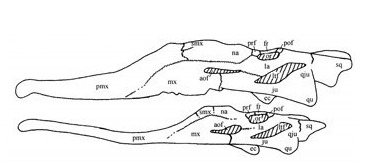
Pseudopalatus buceros skulls, exemplifying the general morphology of phytosaur skulls as well as interspecific variation. Notice massive premaxila.
The most classical thing you’ve ever heard about phytosaurs was how they differ from crocodiles in having the nostrils be close to the eyes/on top of the head rather than at the tip of the snout. This is true; as you can see, the nostrils are located in front or above the eyes in a “volcano-like” elevation; combined with the nostril-less and often conical snouts, this gives them a distinctive dolphin-like profile.
Like in cetaceans, this nostril placement would come in handy on a mostly aquatic lifestyle, avoiding drag and allowing the animal to surface only a small part of the head and remain concealed underwater. However, unlike cetaceans – and marine reptiles such as plesiosaurs -, this nostril position is not derived from nasal retraction. In fact, phytosaur nostrils are sometimes noted as being rather protracted, sometimes as a result of the general elevation of the nasal region.
Instead, what happened is that phytosaurs elongated the premaxila at the expense of the other skull bones. Unlike crocodiles – and whales and plesiosaurs and many other aquatic tetrapods -, half or more of the phytosaur upper jaw is composed of a single bone, normally a vestige at the end of the jaw in most amniotes, that expanded radically. This hints at a pretty rapid elongation of the snout, explaining maybe why long-snouted phytosaurs appear “out of nowhere” in the fossil reccord.
Predictably, this could also hint at rather atypical development, which is etremely important in dictating the presence or absence of lips.
Another frequently cited difference is the presence of antorbital fenestrae. These are the famous “holes” in front of the eyes present in most dinosaurs and other archosauriform reptiles. Crocodiles have lost them, but they are present in phytosaurs, though they can be reduced in some species. Perhaps associated with this, phytosaurs also have extensive antorbital sinuses, while crocodilians lack them altogether. Phytosaurs also have an extensive premaxillary sinus, though as crocodilians have most of their snout taken by the nasal airways this may not make a lot of difference.
With a few exceptions, most aquatic crocodilians have conical teeth; they compensate for the lack of meat-cutting speciations with the infamous “death-rolls”. Phytosaurs, by contrast, generally have serrated teeth, and combined with the presence of crests on many specimens it seems unlikely that these animals engaged in “death-rolls”, instead opting for more typical meat-eating behaviours. To date longirostrine phytosaurs are the only “gharial-like” vertebrates with serrated teeth, and it might explain why they were frequently associated with the carcasses of terrestrial vertebrates like rhynchocephalians and dinosaurs.
Unlike the teeth of crocodiles, phytosaur teeth seem to be rarely interlocked. Even without lips, it seems likely that the upper jaw teeth covered the lower jaw ones.
What about the lips?
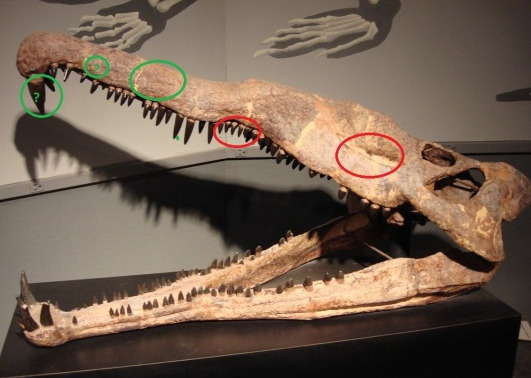
Leptosuchus skull, illustrating the basic points for and against phytosaur lips. For are in red: anteorbital fenestra and serrated teeth. Against are in green: long prexmaxila, POSSIBLE ISOs, front teeth POSSIBLY too large to fit within lips. The latter two are of course ambiguous.
With the above in mind, the absence for or against phytosaurian lips is…mixed.
The rapid premaxilary development in phytosaurs is the key to understanding how the jaw integument of these animals worked. It is possible that the premaxila’s growth prevented the formation of conventional lips, either due to physical and metabolic constraints or because the same genes triggering it could have prevented the development of lips. Perhaps the same pressures causing the crocodilian “single scale” would have been forced on phytosaurs by this developmental quirk.
On the other hand, other parts of the phytosaur skull anatomy seem to suggest the presence of lips:
The aforementioned antorbital fenestrae suggests that the phytosaur skull was less “skin-tight” than that of crocodilians. In modern birds, the only living reptiles with antorbital fenestrae, that area of the skull is covered by various soft tissues, and indeed areas of the avian beak devoid of a rhamphotheca tend to be covered by fleshy lips.
Serrated teeth tend to be more vulnerable than conical teeth to degradation, so most predatory animals that possess them have them covered by lips. The only crocodilians with clearly serrated teeth are terrestrial species and the fairly basal thalattosuchians, which are still on the limbo on whereas they had lips or not.
It is possible that phytosaurs found themselves in an unique integumental arrangement. Perhaps they did become lipless, with a “single scale” covering the jaws, while the rest of the head had a more normal integument.
A deciding factor in this argument would be the discovery of ISOs on phytosaur jaws. However, structures associated with these organs, such as pits, are rarely discussed outside of the context of pathology when it comes to these animals. There is plenty of literature on pits and holes in phytosaur skulls being caused by fights and bites, but few on any possible natural ones.
Conclusion
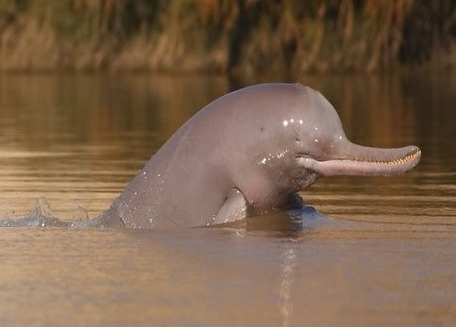
Modern Ganges River Dolphin. Although it has exposed teeth, it’s also not the norm among cetaceans.
Just because something resembles another doesn’t mean that there is an exact equivalency. Case in point: no matter how close phytosaurs got to crocodilians, they still differed in many aspects, and could not be mistaken for them in life.
It’s clear that skin-wrapping is a tremendous lack of appreciation for the organic nature of extinct animals. The lack of lips in crocodilians has been taken far too long to be the “norm”; but, as it turns out, it is an anomaly among the usual amniote tendencies.
We may never know for sure whereas phytosaurs had lips or not. Hell, it’s even possible that some had while others went full Platanista. However, far too often are they taken to be crocodile-like for granted, without other possibilities, equally as valid as they are, taking into consideration.
Hopefully, further research will grant us insights on how these already spectacular animals looked in life.
References:
Reisz, R. R. & Larson, D. (2016) Dental anatomy and skull length to tooth size rations support the hypothesis that theropod dinosaurs had lips. 2016 Canadian Society of Vertebrate Paleontology Conference Abstracts, 64-65.
Grigg, G., & Kirshner, D. (2015). Biology and evolution of crocodylians. Csiro Publishing.
Soares, D. (2002). Neurology: an ancient sensory organ in crocodilians. Nature, 417(6886), 241-242.
Stocker, M. R. & Butler, R. J. 2013. Phytosauria. Geological Society, London, Special Publications 379, 91-117.
Kimmig, J. 2013. Possible secondarily terrestrial lifestyle in the European phytosaur Nicrosaurus kapfii (Late Triassic, Norian): a preliminary study. Bulletin of the New Mexico Museum of Natural History and Science 61, 306-312.
Gozzi, E. & Renesto, S.A. 2003. Complete specimen of Mystriosuchus (Reptilia, Phytosauria) from the Norian (Late Triassic) of Lombardy (Northern Italy). Rivista Italiana Di Paleontologia e Stratigrafia 109(3): 475-498.
Michelle R. Stoker; Sterling J. Nesbitt; Li-Jun Zhao; Xiao-Chun Wu; Chun Li (2016). “Mosaic evolution in Phytosauria: the origin of long-snouted morphologies based on a complete skeleton of a phytosaur from the Middle Triassic of China”. Society of Vertebrate Paleontology 76th Annual Meeting Program & Abstracts: 232.
4 notes
·
View notes
Note
Would beaks on some theropods explain the exposed teeth problem with early reconstructions better or about the same as jowls or just lips?
I mean, that's my hypothesis if I'm being completely honest, that they have beaks instead of lips or jowls in most cases
14 notes
·
View notes